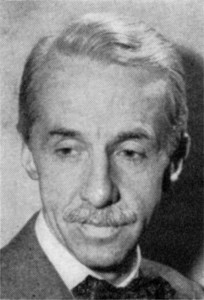What Typography Owes to O.A. Dickman
When any group of New York printers gathers to organize an exhibition, plan a testimonial dinner, or form still another committee, the first nominee is a tall, slim, and distinguished gentleman, complete with moustache and bow tie—O. Alfred Dickman, known to everyone as “Dick.”
For over 30 years few industry affairs have been without his presence as an official, guest, or observer. While he is happy to lend support to almost any cause, Alfred Dickman is most at home with ones in which typography plays a part—Typophiles, Type Directors Club, and American Institute of Graphic Arts exhibits, such as Printing for Commerce, Fifty Books of the Year, and about 50 more.
Next year Dick will complete 30 years as advertising production manager of the New York Herald Tribune. However, the period in his life which he looks upon with the most nostalgia was spent in the Mount Vernon (New York) plant of William Edwin Rudge. This employment coincided with that of the late Bruce Rogers. The “Rudge alumni” also include such well known typographic figures as Peter Beilenson, originator of the Peter Pauper Press, and James Hendrickson, who later collaborated with Rogers in the writing of Paragraphs on Printing.
During the first World War, Dick served in Army Ordnance. His introduction to the composing room followed, in his home twon of West Haven, Conn., and later he became connected with Columbia University Press, under Douglas C. McMurtrie. The latter was a widely known graphic arts figure and a noted typographer, and it was from him that Dick received his first interest in type. His later affiliations were with two other important printing plants of that period, the Condé Nast Press and the Bartlett-Orr Press.
When compositor Dickman decided that he should complete his formal education, he enrolled at Carnegie Institute of Technology. Because of his experience, he was able to work as a part-time instructor in hand composition in a Pittsburgh high school.
This teaching experience prompted Dick to volunteer his services for a 12-year stint in the teaching of advertising typography in the industry classes run by the New York Emploing Printers Association. It was here that he influenced greatly the subsequent careers of literally hundreds of young men and women who took this course. Dickman, always ready to help his students, soon became a one-man employment service for young typographers, giving them both advice and inspirational help.
While he has been a judge in countless exhibitions, one of the tasks which Dick enjoyed the most was that of critic for the Tileston & Hollingsworth calendar in 1951. As the critic is frequently berated by his audience for his choices, this is always a lively assignment in which a solid foundation of typographic knowledge is virtually a requirement. O. Alfred Dickman is the possessor of such a background. His many friends hope that he will grace the New York typographic scene for a long time to come.
This article first appeared in the June 1961 issue of The Inland Printer/American Lithographer.

Thanks for posting this piece about my grandfather!